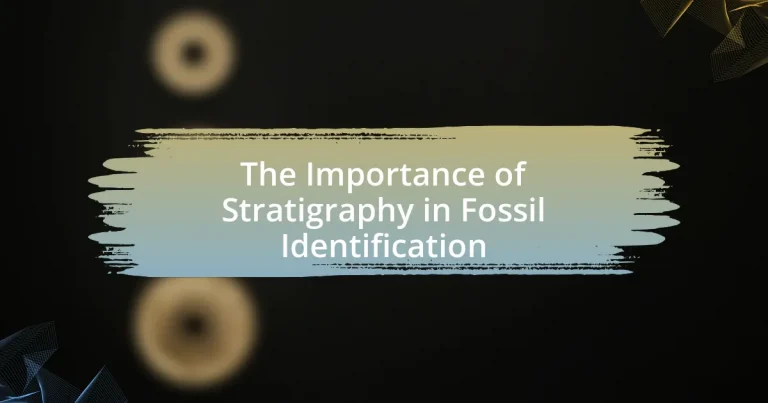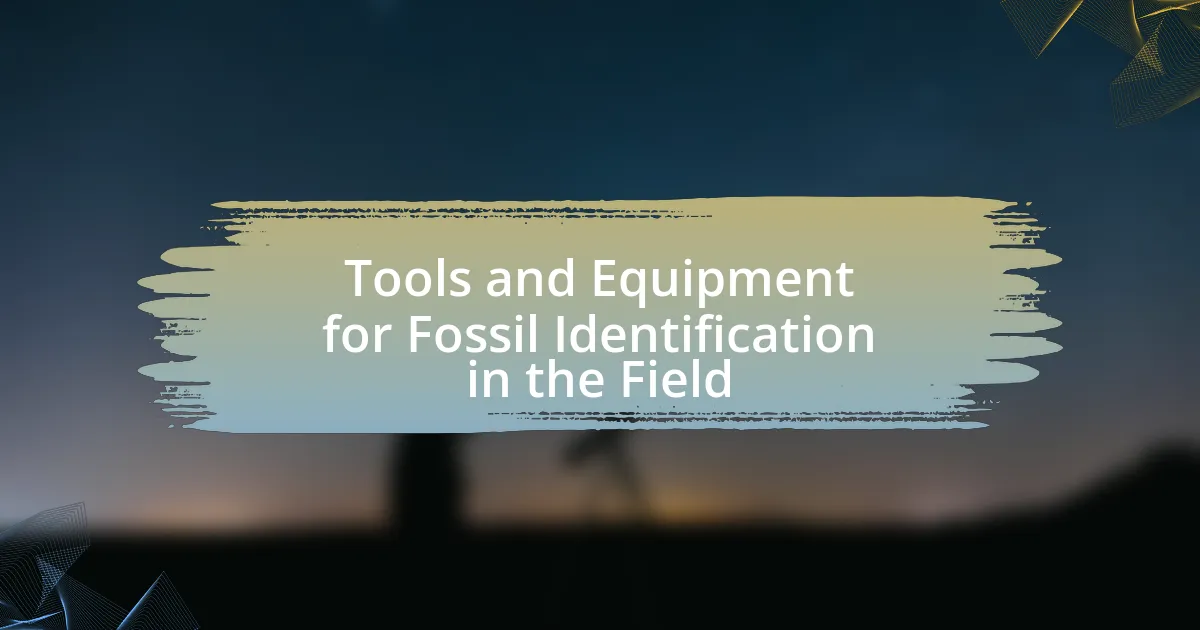Stratigraphy is a fundamental discipline in geology that plays a critical role in fossil identification by providing the context necessary for understanding the age and environmental conditions of fossilized remains. This article explores the importance of stratigraphy, highlighting key principles such as the Law of Superposition, which aids in dating fossils and reconstructing past ecosystems. It discusses how stratigraphy contributes to the understanding of fossil records, the challenges faced in its application, and the techniques that enhance its effectiveness in paleontological studies. Additionally, the article emphasizes the interdisciplinary approaches and best practices that improve the accuracy of fossil identification through stratigraphic analysis.

What is the Importance of Stratigraphy in Fossil Identification?
Stratigraphy is crucial in fossil identification as it provides the context for understanding the age and environmental conditions of fossilized remains. By analyzing the layers of sedimentary rock, scientists can determine the relative ages of fossils and establish a chronological framework for their existence. For instance, the Law of Superposition states that in undisturbed strata, older layers are found beneath younger ones, allowing paleontologists to date fossils accurately. This stratigraphic context also aids in reconstructing past ecosystems and understanding evolutionary processes, as specific fossils are often associated with particular geological periods.
How does stratigraphy contribute to understanding fossil records?
Stratigraphy contributes to understanding fossil records by providing a framework for dating and correlating sedimentary layers where fossils are found. This discipline allows scientists to establish the relative ages of fossils based on their positions within these layers, known as the Law of Superposition, which states that in undisturbed strata, older layers are found beneath younger ones. Additionally, stratigraphy aids in reconstructing past environments and ecological contexts by analyzing the composition and characteristics of sedimentary deposits, which can indicate the conditions under which the fossils were formed. For instance, the presence of certain sediment types can suggest marine or terrestrial environments, thereby enhancing the interpretation of the fossil record.
What are the key principles of stratigraphy relevant to fossils?
The key principles of stratigraphy relevant to fossils include the Law of Superposition, the Principle of Original Horizontality, and the Principle of Faunal Succession. The Law of Superposition states that in undisturbed sedimentary rock layers, older layers are found below younger layers, allowing for chronological dating of fossils. The Principle of Original Horizontality posits that sedimentary layers are originally deposited in horizontal layers, which aids in understanding the geological history of fossilized organisms. The Principle of Faunal Succession indicates that fossil organisms succeed one another in a recognizable order, enabling geologists to correlate and date rock layers based on their fossil content. These principles are foundational in reconstructing the history of life on Earth and understanding the temporal context of fossil finds.
How does stratigraphy help in dating fossils?
Stratigraphy helps in dating fossils by analyzing the layers of sedimentary rock in which fossils are found, allowing scientists to establish a chronological sequence of events. The principle of superposition states that in undisturbed layers, older layers are found beneath younger layers, enabling researchers to determine relative ages of fossils based on their stratigraphic position. For instance, fossils found in lower strata are typically older than those in upper strata, providing a framework for understanding the geological timeline. Additionally, radiometric dating techniques can be applied to the volcanic layers above or below fossil-bearing strata, offering precise age estimates. This combination of relative and absolute dating methods reinforces the accuracy of fossil dating through stratigraphy.
Why is stratigraphy essential for paleontologists?
Stratigraphy is essential for paleontologists because it provides a framework for understanding the temporal and spatial distribution of fossils within sedimentary rock layers. This discipline allows paleontologists to date fossils accurately and reconstruct past environments by analyzing the sequence and characteristics of rock strata. For instance, the Law of Superposition states that in undisturbed layers, older layers are found beneath younger ones, enabling scientists to establish a chronological order of fossilized organisms. Additionally, stratigraphy aids in correlating rock layers across different geographic locations, which is crucial for understanding evolutionary trends and biogeographic patterns.
What role does stratigraphy play in reconstructing ancient environments?
Stratigraphy plays a crucial role in reconstructing ancient environments by providing a framework for understanding the chronological sequence of geological and biological events. Through the analysis of sediment layers, stratigraphy reveals information about past climates, ecosystems, and the processes that shaped the Earth’s surface. For instance, variations in sediment composition and fossil content within these layers can indicate changes in environmental conditions, such as shifts from marine to terrestrial habitats. This method has been validated by numerous studies, including the work of geologists who have correlated specific stratigraphic units with known historical climate events, thereby demonstrating the reliability of stratigraphy in interpreting ancient environmental contexts.
How does stratigraphy assist in identifying fossil species?
Stratigraphy assists in identifying fossil species by providing a chronological framework that allows scientists to understand the relative ages of rock layers and the fossils contained within them. This method relies on the principle of superposition, where lower layers are older than those above them, enabling paleontologists to correlate fossil finds across different locations. For instance, the presence of specific index fossils, which are species known to have existed during particular time periods, helps in dating the strata and identifying the corresponding fossil species. This approach has been validated through extensive geological studies, such as the use of the fossil record in the geological time scale, which categorizes Earth’s history based on stratigraphic data.
What challenges do scientists face in using stratigraphy for fossil identification?
Scientists face several challenges in using stratigraphy for fossil identification, primarily due to issues related to sedimentary processes and the preservation of fossils. The stratigraphic record can be incomplete or distorted due to erosion, tectonic activity, or sedimentation rates, which complicates the correlation of fossil layers across different locations. Additionally, the diagenesis process can alter fossils, making them difficult to identify accurately. For instance, fossils may undergo chemical changes that obscure their original morphology, leading to misidentification. Furthermore, the presence of time gaps in the stratigraphic record, known as unconformities, can hinder the understanding of evolutionary timelines. These challenges necessitate careful analysis and often require complementary methods, such as radiometric dating or biostratigraphy, to enhance the accuracy of fossil identification.
What are the limitations of stratigraphic methods in paleontology?
Stratigraphic methods in paleontology have several limitations, primarily related to the incompleteness of the geological record. The geological record is often fragmented due to erosion, non-deposition, or tectonic activity, which can lead to gaps in the stratigraphic sequence. Additionally, stratigraphic correlation can be challenging when dealing with different sedimentary environments, as variations in deposition can obscure the chronological relationships between fossil assemblages. Furthermore, the reliance on lithological characteristics may not always accurately reflect the temporal distribution of fossils, leading to potential misinterpretations of evolutionary timelines. These limitations highlight the need for complementary methods, such as biostratigraphy and radiometric dating, to enhance the accuracy of paleontological interpretations.
How can errors in stratigraphy affect fossil interpretation?
Errors in stratigraphy can lead to significant misinterpretations of fossil data. When stratigraphic layers are inaccurately dated or misidentified, the chronological context of fossils becomes distorted, potentially leading to incorrect conclusions about their age, evolutionary relationships, and environmental conditions. For instance, if a fossil is believed to be from a different geological period due to stratigraphic errors, it may be incorrectly associated with certain species or ecological scenarios, undermining the accuracy of paleontological studies. This has been evidenced in cases where misidentified strata have resulted in the erroneous placement of fossils within the evolutionary timeline, affecting our understanding of biodiversity and extinction events.
How does stratigraphy relate to other geological sciences?
Stratigraphy is a fundamental branch of geology that studies rock layers and layering, which is essential for understanding the geological history of Earth. It relates to other geological sciences, such as paleontology, sedimentology, and geochronology, by providing a framework for dating and correlating rock layers, which in turn helps in the identification and interpretation of fossil records. For instance, paleontology relies on stratigraphic principles to determine the age and environmental context of fossils, while sedimentology uses stratigraphic data to analyze sedimentary processes and environments. Geochronology, which focuses on dating geological events, often utilizes stratigraphic relationships to establish a chronological sequence of rock formations. Thus, stratigraphy serves as a critical link that integrates various geological disciplines, enhancing our understanding of Earth’s history and the evolution of life.
What techniques enhance the effectiveness of stratigraphy in fossil studies?
Techniques that enhance the effectiveness of stratigraphy in fossil studies include biostratigraphy, lithostratigraphy, and chronostratigraphy. Biostratigraphy utilizes fossil distribution to correlate and date rock layers, providing insights into the relative ages of fossils. Lithostratigraphy focuses on the physical and chemical characteristics of rock layers, aiding in the identification of depositional environments. Chronostratigraphy employs radiometric dating methods to establish absolute ages of strata, allowing for precise temporal frameworks. These techniques collectively improve the accuracy of fossil identification and interpretation by establishing a clearer context for the fossils within geological time.
How do modern technologies improve stratigraphic analysis?
Modern technologies enhance stratigraphic analysis by providing advanced tools for data collection, visualization, and interpretation. Techniques such as 3D seismic imaging allow geologists to visualize subsurface structures in detail, improving the accuracy of stratigraphic correlations. Additionally, high-resolution geochronology methods, like U-Pb dating, enable precise age determinations of rock layers, facilitating better temporal correlations. The integration of Geographic Information Systems (GIS) aids in spatial analysis and mapping of stratigraphic units, allowing for more comprehensive assessments of geological formations. These technologies collectively lead to more reliable interpretations of stratigraphic sequences, which is crucial for fossil identification and understanding past environments.
What interdisciplinary approaches benefit stratigraphic research?
Interdisciplinary approaches that benefit stratigraphic research include geology, paleontology, geochemistry, and archaeology. Geology provides the foundational understanding of rock layers and their formation processes, while paleontology contributes insights into the biological context of fossilized remains within those layers. Geochemistry aids in analyzing the chemical composition of sediments, which can reveal environmental conditions at the time of deposition. Archaeology offers methods for dating and contextualizing human artifacts within stratigraphic sequences. These combined disciplines enhance the accuracy of stratigraphic interpretations and improve fossil identification by integrating various lines of evidence.
What best practices should be followed in stratigraphic studies for fossil identification?
Best practices in stratigraphic studies for fossil identification include meticulous documentation of sedimentary layers, precise mapping of fossil locations, and the use of stratigraphic correlation techniques. Meticulous documentation ensures that the context of each fossil is preserved, which is critical for understanding its geological age and environmental conditions. Precise mapping allows researchers to visualize the spatial distribution of fossils within the stratigraphic framework, facilitating better interpretations of paleoenvironments. Stratigraphic correlation techniques, such as biostratigraphy and lithostratigraphy, help in establishing chronological relationships between different fossil-bearing strata, enhancing the accuracy of fossil identification. These practices are supported by the principle that the geological context is essential for accurate paleontological analysis, as highlighted in studies like “Principles of Stratigraphy” by K. M. D. H. and “Fossil Record and Stratigraphy” by J. Smith.





